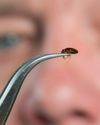
Out there among the stars lies a hidden swarm of black holes. They have been around ever since the dawn of time, quietly and not so subtly influencing the evolution of the universe. Without them, there would be no stars, no planets, and no life to marvel at the universe's wonders. Now, for the first time, we may finally have the tools to find them. Black holes are one of astronomy's most famous objects. Their gravity is so extreme that escape is impossible if you venture too close. There are different sizes of black holes, but they are normally gargantuan monsters considerably more massive than our own sun. They usually remain hidden from view because no light can escape to reveal them to us.
Yet we have seen them, thanks to gravitational wave detectors like LIGO and VIRGO that have detected signals from colliding black holes. We've never been more confident that these cosmic trapdoors exist.
However, there is one type of black hole that still remains theoretical - one that could solve a longstanding cosmological conundrum to boot.
Immediately after the Big Bang, there were small fluctuations in the new universe's density - regions that had slightly more or less mass than the average. Where the mass was above the norm, the material could have collapsed to form mini black holes. As they've been around for pretty much as long as the universe itself, these black holes are called 'primordial' black holes.
According to theoretical models, primordial black holes can have a wide range of masses. They could be lighter than an eyelash or heavier than a star. So far, we've been able to rule out some masses through observations, opening up two possible mass ranges or 'windows' for primordial black holes.
This story is from the March/April 2022 edition of Very Interesting.
Start your 7-day Magzter GOLD free trial to access thousands of curated premium stories, and 9,000+ magazines and newspapers.
Already a subscriber ? Sign In
This story is from the March/April 2022 edition of Very Interesting.
Start your 7-day Magzter GOLD free trial to access thousands of curated premium stories, and 9,000+ magazines and newspapers.
Already a subscriber? Sign In

TAKE IT SLOW
Slow running is a fitness trend with some hard and fast science behind it

Physics, AI and music share a common thread. You just have to know where to look
Studying science can lead you in many directions and open doors to unexpected possibilities along the way

BED BUGS VS THE WORLD
When bloodthirsty bed bugs made headlines for infesting Paris Fashion Week in 2023, it shone a spotlight on a problem that's been making experts itch for decades: the arms race going on between bed bugs and humans

Kids are the key to understanding obesity. But we need more of their genes...
We can unravel the role that bodyweight plays in disease, but we need a bigger, more diverse, sample of genetic material to do so

COVID inquiry: What did we learn and what can we do better in future pandemics?
Masks, social distancing, lockdowns... how effective was the UK's response to the COVID-19 pandemic?

One hormone could be the key that unlocks a cure for morning sickness
The nausea and vomiting that, in extreme cases, can endanger mothers and babies might soon be just a memory

THE WORLD'S WEIRDEST CREATURES
Under the sea and upon the land, some animals look - to us - pretty strange...

WHEN MIND AND MACHINE COLLIDE
First, Elon Musk wanted to make electric cars ubiquitous, then he wanted to make space exploration a private enterprise. Now, with Neuralink, his newest venture, Musk hopes to merge humans and artificial intelligence. Turns out, it might not be such a crazy idea...

COME OUT OF YOUR SHELL
Social anxiety is more than just being shy. It's a phobia born out of our evolutionary past. But that raises a puzzling question: why do so many of us fear human interaction when we're supposed to be the most sociable species on the planet?

SPACE ODDITIES
Take a tour of the weirdest spots in the universe, where the 'normal' rules don't apply. Places that squeeze time, blow bubbles and even rain glass... sideways